One-day Training on Using Harm Reduction approach within ASAM Criteria Framework
The ASAM Criteria provides guidelines focusing on coordinating medical care, providing therapeutic alternatives, evaluating safety, addressing co-occurring disorders, involving social supports, and documenting clinical needs within the framework of the six dimensions. This includes setting and evaluating individualized measurable treatment goals which drive variable lengths of stay based on the needs of the person served. The Criteria centers on the clinically indicated intensity of care based on an ongoing assessment, determining progress based on the individualized plan of care, making appropriate referrals and recommendations, and providing adequate social support referrals when needed. This training provides skill building in the use of the ASAM Criteria as a framework for determining the most appropriate intensity of services and how a harm reduction model/approach; specifically providing strategies for working with clients on goal setting, application of risk reduction skills and evaluation of treatment goals fits within the broader framework of the Criteria’s six dimensions and levels of care.
